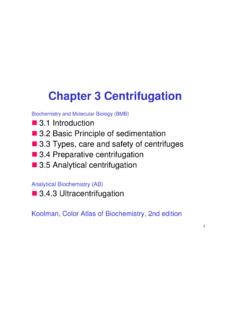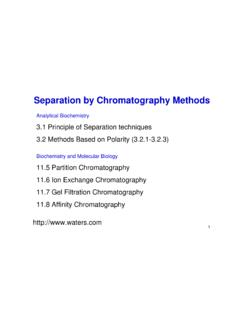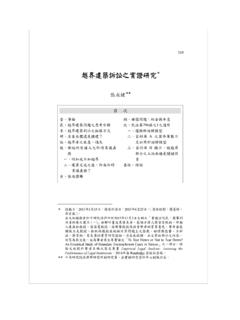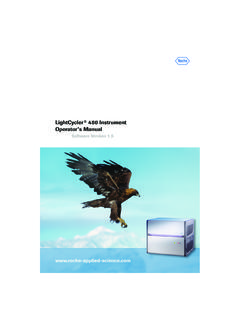Transcription of Structure, crystal fields, magnetic interactions, and …
1 structure , crystal fields, magnetic interactions , and heavy-fermion behavior in Ce12xLax 3 AlY. Y. Chen and Y. D. YaoInstitute of Physics, Academia sinica , Taipei, Taiwan, Republic of ChinaB. C. Hu and C. H. JangDepartment of Physics, Fu Jen University, Taiwan, Republic of ChinaJ. M. LawrenceDepartment of Physics, University of California, Irvine, California 92717H. Huang and W. H. LiDepartment of Physics, National Central University, Taiwan, Republic of China~Received 6 May 1996!We report measurements of the resistivityr, susceptibilityx, and specific heatCof the alloys~Ce12xLax!
2 3Al. At room temperature these form in the hexagonal Ni3Sn structure ~a-Ce3Al!; at low tempera-tures a structural transition to a monoclinic phase occurs for 0<x< ~g-Ce3Al!; and a transition with asimilar feature in the resistivity occurs for ,x<1~g-La3Al!. crystal fields have strong effects on thesemeasurements: analysis of the specific heat suggests that for Ce3Al two excited doublets occur at temperaturesT1cf'75 K andT2cf'130 K above the ground-state doublet, and that these splittings decrease significantly onalloying; this causes a similar decrease in the Curie-Weiss temperatureuhobtained from the high-temperaturesusceptibilityx5C/(T1uh) .
3 The derivativedr/dTof the low-temperature resistivity is negative over a rangeof temperature for allx(0<x,1), which is a characteristic sign of heavy-fermion~Kondo!behavior; variousmeasures of the Kondo temperatureTK, taken from the analysis ofr,x, andC, consistently suggest thatTKdecreases by an order of magnitude on alloying, from'10 K for smallxto'1 K for largex. Fits to thelow-temperature specific heat which include a lattice contribution, a crystal -field contribution, and anS51/2 Kondo contribution describe the data well ; but for <x< the specific heat peak is larger andnarrower than predicted by Kondo theory and a peak occurs in the resistivity, suggesting that coherence due tomagnetic correlations plays a role for these concentrations.
4 For the monoclinic phase, peaks inr,x, andCindicate antiferromagnetic order, where the Ne el temperature decreases withxfrom its K forx50. The specific heat is linear at the lowest temperatures, even in the antiferromagnetic phase, whichsuggests that the magnetic order coexists with Kondo INTRODUCTIONH eavy-fermion behavior is observed1in the systems Ce3X~X5In, Sn, Al!. For Ce3Al, the room-temperature phase~a-Ce3Al!is hexagonal~Ni3Sn!but a structural transitionoccurs atTs5110 ,2An initial study3using conventionalx-ray diffraction found that the low-temperature state alsohas the Ni3Sn structure .
5 However, Rietveld refinement of thestructure using high-resolution diffraction data from a spal-lation neutron source found the low-temperature phase to bemonoclinic;4the monoclinic structure was confirmed5usingneutron data from a triple-axis spectrometer. In thisg-Ce3 Alphase antiferromagnetic order occurs low-temperature resistivity exhibits a negative de-rivativedr/dT; this Kondo effect establishes that the mag-netic order occurs at a temperature where heavy-fermion pro-cesses are active in removing the spin entropy. A commonway to study the resulting interplay between magnetic orderand heavy-fermion behavior is through substitution of non- magnetic La for Ce.
6 Older studies6,7of the resistivityr(T)and susceptibilityx(T) from 2 300 K in the system~Ce12xLax!3Al explored a limited range of alloy concentra-tion (x, ); these show that the low-temperature structuraltransition vanishes ; ,Ts(x)!0 for ,x, A study8of the specific heatC(T) for 0<x< K,T,300 K suggests that the Ne el temperatureTNinitially decreases withx, but then saturates to a value oforder this paper we report a more thorough study, whereinr,x, andCare all measured for a series of alloys spanning therange 0<x<1. The measurements ofC(T) and~for selectcompounds!
7 Ofr(T) were extended to a lower temperature~ K!than in the previous studies. In the analysis and dis-cussion we focus on the interplay between structure , crystalfields, magnetic interactions , and the Kondo EXPERIMENTAL DETAILSP olycrystalline samples of~Ce12xLax!3Al forx50, , , , , , , , , and 1 were prepared byarc melting the constituent elements in an argon Ce~ !,Al~ !, and La~ !were obtained from the Johnson Matthey Company. Toavoid oxidation the cerium was prepared in a pure nitrogenatmosphere. The as-cast samples were then annealed atPHYSICAL REVIEW B1 MARCH 1997-IVOLUME 55, NUMBER 9550163-1829/97/55~9!
8 /5937~7!/$ 1997 The American Physical Society200 C for 10 days to eliminate any residual high-temperature cubicb-Ce3Al phase. X-ray diffraction was per-formed at room temperature for allxon polished bulk speci-mens using a rotating anode diffractometer manufactured byMaterials Analysis and Characterization. These studies dem-onstrate that at room temperature the alloys have the Ni3 Snstructure for allxwith no evidence for second phases withinthe detection limits~a few percent!of the instrument. Thelattice constants vary smoothly withx~Fig. 1!. For Ce3 Aldiffraction measurements on these polished specimens werealso measured at low temperature; for both Ce3Al and La3 Aladditional studies~discussed below!
9 At room temperature andlow temperature were performed on annealed powdersformed by filing the bulk ingots. The specific heat was mea-sured in the range 60 K using a thermal-relaxationmicrocalorimeter9and samples of approximately 232mm2cross section and mm thickness. Measurements of themagnetic susceptibility for ,T,300 K were imple-mented in a superconducting quantum interference devicewhich was calibrated with a palladium standard prior to themeasurements. Resistivity measurements for ,T,300 Kwere performed by the standard four-probe method onsamples with a rectilinear geometry; , thelower limit onTwas K; , the lower limit onTwas K.
10 To establish reproducibility, measurementswere performed on two batches of RESULTS AND ANALYSISThe resistivity of~Ce12xLax!3Al alloys for 0<x<1asafunction of temperature is shown in Fig. 2. The hystereticstructural transition which occurs nearTs5110 K for Ce3 Algives rise to a nonmonotonic feature in the resistivity. Thetransition temperatureTsdecreases rapidly on alloying, andis not visible ; but a similar feature in theresistivity is observed Low-temperaturex-ray diffraction on polished and powdered samples ofCe3Al exhibited a profile consistent with that expected forthe monoclinic high multiplicity lines of theNi3Sn structure are split in the monoclinic structure .









